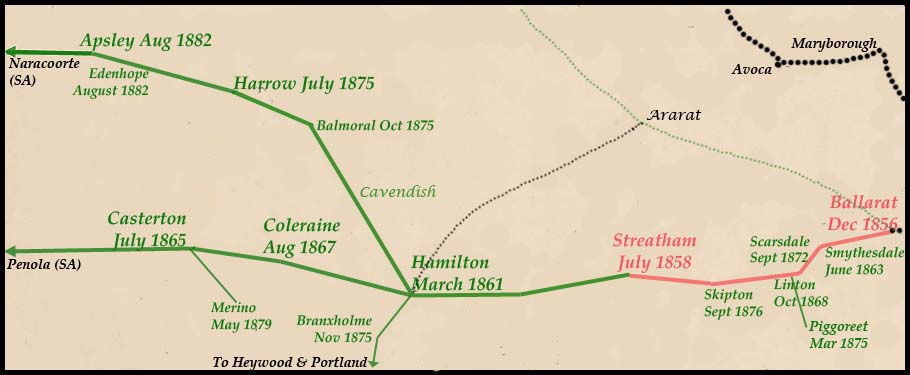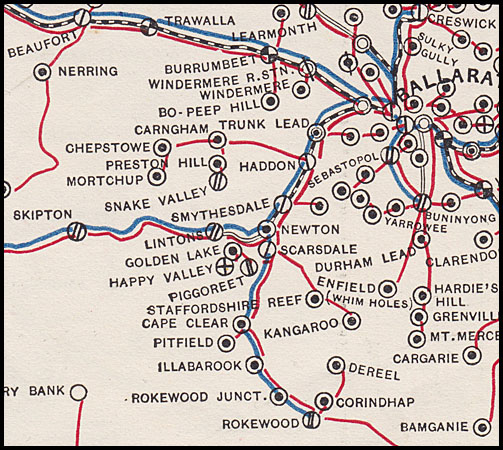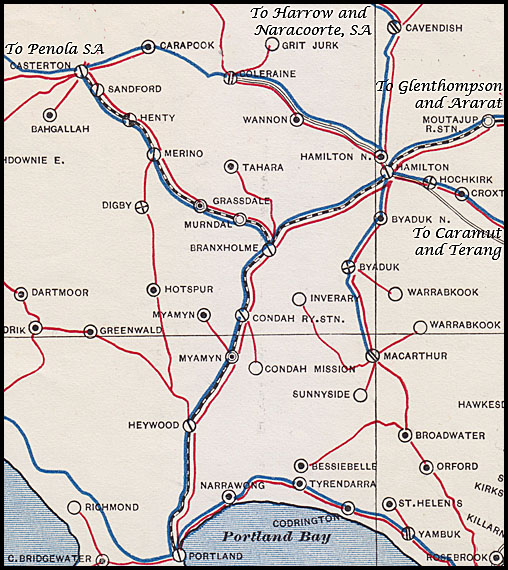The Cross Country Western line and Branches.
- Home, index, site details
- Australia 1901-1988
- New South Wales
- Overview of NSW
- Telegraph lines
- Telegraph Offices
- Date stamps
- Forms
- Envelopes
- Rates
- Stamps
- Queensland
- Overview of Qld
- Telegraph lines
- Telegraph offices
- Date stamps
- Forms
- Envelopes
- Rates
- Stamps
- South Australia
- Overview of SA
- Telegraph lines
- Telegraph Offices
- Date stamps
- Forms
- Envelopes
- Rates
- Stamps
- Tasmania
- Overview of Tasmania
- General developments
- Reports
- Organisation
- Telegraph lines
- Telegraph Offices
- Date stamps
- Railway lines
- Forms
- Envelopes
- Rates
- Stamps
- Overview of Tasmania
- Victoria
- Overview of Vic.
- Telegraph lines
- Telegraph offices
- Date stamps
- Forms
- Envelopes
- Rates
- Stamps
- Ephemera
- Western Australia
- Overview of WA
- Telegraph lines
- Telegraph Offices
- Date stamps
- Forms
- Envelopes
- Rates
- Stamps
After the first line to South Australia had been constructed, priorities for new lines were centered further north. The focus started to shift to a possible second connection with South Australia through Casterton or thereabouts.
 |
The definition of the line varied over the years. From that shown elsewhere for 1858, the route was changed by 1863 and then further modified in a significant way by 1880. The changes were required because of the need to strengthen the lines to the west from Ballarat rather than move directly towards the south.
The Cross-Country Western line is perhaps the most complex when considering all the branch lines which were constructed from it. Consequently it must be described in stages:
- the main line from Ballarat to Hamilton;
- the Buninyong and Rokewood extensions just south of Ballarat;
- the Portland to Hamilton branch;
- the Casterton branch to Penola S.A.
- the Apsley branch to Naracoorte S.A.
An inter-connection between two major lines took place in 1884 when a 66.5 mile line connected the Horsham line from Ararat to the Cross-Country Western line at Hamilton (1884 Report, p. 38). In 1907, this Hamilton-Ararat line was duplicated/replaced and extended to Avoca.
The main line - Ballarat to Hamilton.
The Cross-Country Western line started at Ballarat. The Ballarat Star of 28 November 1862 noted that "The connection of Smythesdale by telegraph with Ballarat and other parts of the colony is now being done, and the posts to carry the wires, are erected along a portion of the route, Armstrone and Skipton streets being the course taken through the municipality of Ballarat".
The existing lines were used where possible to link to Streatham - one of the stations erected on the first line to South Australia. Beyond that, new lines were erected to Lake Bolac, Glen Thompson and Dunkeld on the way to Hamilton.
A station had been constructed in 1861 at Hamilton with plans for it to be an alternative or even a substitute route to the Southern Coast line - and so replace the Hexham-Warrnambool component of the original line. Intermediate stations were constructed progressively at Smythesdale in 1863 and Linton in 1868.
The Buninyong and Rokewood extensions.
 Detail of the Skipton - Scarsdale - Ballarat region and the extensions to Buninyong and Rokewood. Taken from a map in the 1887 Annual Report. The blue lines are the telegraph lines. |
A short distance from Ballarat, three extensions were made from the Cross-Country Western line to provide telegraphic services to smaller centres (later, by 1890, parts of the line were identified by numbers):
|
The Portland to Hamilton Branch.
 Detail of the Portland-Hamilton line. Taken from a map in the 1887 Annual Report. The blue lines are the telegraph lines. |
The Portland Guardian of 13 February 1860 reported that "when Mr. Mollison proposed in the House on the 7th inst. that a telegraph line should be erected between Portland and Hamilton, the Treasurer, Mr. McCulloch, declared there were no funds for such a purpose - softening his refusal, however, by the assurance that if there should be any spare money after the Estimates had passed, the project for a telegraph line from Portland to Hamilton would receive the attention of the Government". An amount of £2,143 was agreed with Mr. R. Woolley & Co to build the Hamilton-Portland line. The Argus of 6 November 1860 reported from Hamilton Spectator of 3 November 1860: "We observe that the posts are now laid down to this end of the line, and as little time will be required to put them up, we may hope ere long to have the pleasure of announcing the telegraph to Hamilton as a "great fact".
|
In 1877, the Hamilton to Portland line was shifted to follow the line of railway. Tenders were called in June 1877 for contractors able to do this work.
This branch line of the Cross-Country Western Line was given the alluring and scenic name of Line 98 in the 1890 Report:
Line 98: Portland through Heywood, Condah R, Branxholm to Hamilton.
Not all was plain sailing however. The Portland Guardian of 20 November 1860 reported the following incident which would have taken place perhaps in October:
POLICE COURT. Thursday, 20th Nov., 1860.
Before J. Blair, Esq., P.M., T. Must, Esq., J.P.
Daniel McQuarrie, manager for R. Woolley and Co., contractors for the Telegraph line between Portland, and Hamilton, charged by the Secretary of the Road Board with obstructing the main road to Heywood by allowing fallen trees to remain thereon. The said McQuarrie have received official notice to remove the same.W. Clapham, clerk of the Road Board Board sworn, proved the offence. The road in the nine mile forest is obstructed by fallen trees being allowed to remain on the road. It is a three chain road. The trees were fallen I understand by defendants orders. The road had been cleared of all fallen timber in 1:58. The timber is lying between the telegraph posts and the metalled road.
T. Anderson, Road Board overseer, sworn, testied to the fallen timber lying on the road along the telegraph line. Defendant said : The pegs were put down by engineers and he had to follow them and clear 40 feet round each post. He did not know the road, if the line in some parts were the outside limit, the metalled road would be three chains from the telegraph line. William Williams, overseer of works on the tramway, sworn: Did not know of any obstruction; have never been instructed myself.
A nominal penalty of 40s. was imposed, and 4s 6d costs.
The Cross-Country Western line was extended west from Hamilton to Casterton in 1867 with an intermediate telegraph station opening at Coleraine.
By the mid 1860s, the Mount Gambier-Portland line was at full capacity. At that stage, with a redefinition of the linkages then operating among the lines, a direct Ballarat to Casterton link was possible - and the region close to the South Australian border was all available. It then became possible to develop other South Australian stations with which to make a second or even a third intercolonial link.
In his 1864 Report, McGowan expressed his hopes for the line as follows:
"A .. security against absolute stoppage has been attained on the Western route by the provision of the interior line via Ballarat, Streatham, Hexham and Hamilton to Portland. This connection will be still further perfected when the extension now in progress between Hamilton and Casterton may have been completed and that line may have been extended from Casterton to Penola where it will join the line to Mount Gambier; this I hope to see accomplished within the present year".
In the Mount Gambier Border Watch of 1 July 1865, the following was reported: "Among other gossip of the day we hear that our Government talk of connecting the telegraph from Penola to Casterton. No doubt it will not take long to have a second over-land line between Adelaide and Melbourne which, in stormy weather, will be of great advantage from being exempt from many storms to which the coast line is subject".
Progress of the planning and construction of the line can be sumarised as follows:
- in March 1866, £600 was placed in the estimates for a line from Casterton to the South Australian boundary en route to Penola;
- in June 1866, the specifications were finalised for the construction of the Penola-Casterton Telegraph line;
- on 16 November 1867, the Penola-Casterton intercolonial telegraph line was opened.
In 1896, two lines were dismantled and new lines erected on railway poles:
- from Hamilton to Casterton via Merino;
- between Hamilton and Coleraine.
In the Argus of 17 September 1874, tenders were called for the construction of a line of electric telegraph from Coleraine to Harrow direct, or from Hamilton to Harrow via Cavendish and Balmoral "as may be here after decided upon".
In March 1879, it was reported that "The Victorian Government are considering the desirability of taking steps for the duplication of the telegraph line from Melbourne to Adelaide via Harrow, Edenhope and Apsley with Narracoorte, avoiding the coast connection". Soon after it was agreed the lin would extend from Hamilton to Balmoral and Harrow.
Border Watch of 14 December 1881 reported:
TELEGRAPH TO APSLEY.
"The Postmaster General on Wednesday accepted the tender of Messrs. Jas. Wright and Co. for erecting a telegraph wire from Harrow to Apsley, a distance of 35 miles, the sum being £832. This line will go through Edenhope and has been contracted for on the understanding that the South Australian Government will also extend their telegraphic communication from Narracoorte to Apsley. When this has been completed, another means of communicating by telegraph between the two capitals of Melbourne and Adelaide will have been provided".
On 28 August, 1882, The South Australian Advertiser reported:
"With regard to the construction of the telegraph line from Harrow to Apsley, the Narracoorte Herald of August 23 observes: "The telegraph poles and wires between Harrow and Apsley are erected and, as soon as the necessary furniture arrives, telegraph offices will be opened at Apsley and Edenhope. It is probable that the office at the last-mentioned place will be opened tomorrow under the charge of Miss McFarlane and very likely the Apsley office will be opened next week.
Progress is being made with the erection of poles between Apsley and Narracoorte. There are two contractors at work, both working from the boundary. It is noticeable that the poles on the Victorian side of the boundary are taller and stouter than those on the South Australian side. The Victorian contractor expects to finish in a week".
The completion of the third inter-colonial line - with such a short distance between the two connecting Telegraph Offices in each state - raised the problem of rates to be charged for inter-colonial telegrams spanning only a few miles. The Herald noted:
"In a short time the telegraph will be erected between Narracoorte and Apsley, and as there are close business and social relations between these two places, a good many messages will probably be sent. The distance between the two is nineteen miles, and as Apsley is in Victoria the charge for telegrams will be two shillings for ten words. Port Augusta is several hundred miles from Narracoorte and yet messages can be sent there for half this cost. These small inconveniences—and there are many of them—make life near the border less comfortable than it would be if that imaginary line were wiped off the maps".
In 1896, the line between Hamilton and Casterton was replaced by transferring it to railway poles. A new line between Hamilton and Coleraine was also constructed at that time.
In 1894 the Hamilton-Penshurst line was dismantled and replaced with an 18 mile line as too was the 13 mile line between Mortlake and Terang.
While the first coastal radio stations were being established starting with Sydney and Fremantle, another experiment was being commenced in Victoria. The Portland Guardian of 22 December 1913 reported the situation after a number of failed attempts by the residents of Strathdownie and Casterton:
"WIRELESS TELEGRAPH: The advantage of having an energetic businessman at the head of affairs in a Government department is emphasized in the promptitude with which steps have been taken to proceed with the installation of wireless telegraph stations at Casterton and Strathdownie which were authorised by the Postmaster-General (Hon. Agar Wynne) only a few days ago. Mr. Donald Macdonald, Engineer of the department, came to Casterton on Monday night and on Tuesday visited Strathdownie. He located a site near the hotel and store, which he will recommend to be purchased, and obtained other data for preparing plans for the local station. On Thursday he obtained similar data for the Casterton station, which is to be worked from a mast on top of the Post Office. It is expected these stations will be in use within the next two months. These stations, which are estimated to cost not more than about £200 each (as against from £2,500, to £3,000 expended on each of the big coastal stations), cost very little for maintenance and are being erected, partly to provide through communication with the most powerful long service station at Mt. Gambier, by which they will be controlled and partly as an experiment for inland usage".